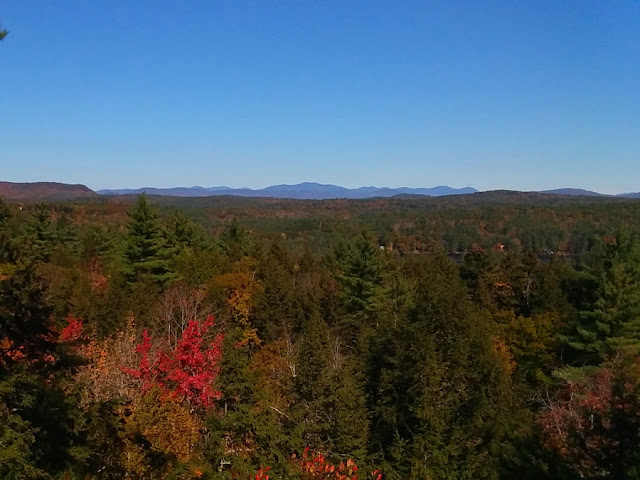While we've been enjoying more fabulous fall weather, the White Mountains to the north have been earning their name with their first coatings of snow. I saw the evidence on October 20th when on a beautiful, blue-sky day, a snow-capped Mt. Lafayette was visible from the White Mountain Ledge in the Hamlin Town Forest.
 |
| You can't make it out in this picture, but there's snow on Mt. Lafayette. |
On that trip I also stopped at the Lake Wicwas view point on the red trail - the lake was as deep blue as I've ever seen it, reflecting that clear blue sky on a breezy day.
 |
| Looking northeast from the Lake Wicwas view point on the Red Trail. |
On the way down from the ledge I noted several trail blazes that have been seriously vandalized by our forest critters.
 |
| Rodent damage on the trail blazes. |
There's always a question of who does this - mice, squirrel, or porcupines. I think it's probably red squirrels because the damaged blazes are widespread and porcupines keep to a small area. Also, the damaged blazes are on all kinds of trees, including some that porcupines don't favor. Finally, the tooth marks on the chewed edges are pretty small, seeming more like a mouse or a squirrel's incisors at work.
But I won't know unless someone catches the culprit in action some day - and even then, there could be multiple species involved. Another question is why. Perhaps they are attracted by the color and then chew on it to sample it, or just to wear down their ever-growing teeth. Sometimes there are elements in paint or in plastic that animals crave, including some salts and minerals. There's probably a whole study that can be done on this subject.
One more nature note from the Hamlin Forest: this huge mushroom crop was growing around the base of nearly-dead oak tree on the trail leading up to Crockett's Ledge:
I was fooled yet again by the loons this week. I saw two loons fishing together and thought for sure it was the two juveniles, Coco and Jimmy, based on their coloring. But when I cropped the pictures I realized that only one of them had the chevron pattern of a juvenile and the other had a few remnants of spots from adult summer plumage, so I assume it was mom with one of the kids.
 |
| Junior (on the right) appears even bigger than mom. |
It's getting late for a parent to still be here but the young ones may stay well into November. The loons have been entertaining lots of company on the lake, this week a group of four male mallards trying to impress a single female.
But there was also an interloper in the group: a ring-necked duck.
 |
| Ring-necked Duck (Aythya collaris) |
Ring-necked ducks are fairly regular visitors to the Lakes Region as they migrate through central New Hampshire between their summer breeding grounds in Canada and the very northern edges of New England and their winter homes south of Connecticut. They're pretty birds with their sharp yellow eye, and white band and black tip on their beak. Just remember that the ring on the neck that gives them their name is rarely visible.
This raises more unanswered questions - why was a different species of duck hanging around with the mallards? At any rate, the mallard drakes didn't seem to appreciate the intruded and kept themselves positioned between the ring-neck and the female.
 |
| The drakes standing guard over the hen. |
I've noticed the number of boats and docks around the lake is getting small now, but there are are still fishing boats and kayaks out enjoying the fine weather. Sunrises and sunsets have been plentiful too, including this brilliant sunrise that Neil Crimins caught and was kind enough to send to me.
 |
| Morning light shines on the hills behind the mirror of Lake Wicwas. Photo by Neil Crimins. |
We better enjoy it while it's here - snow on Mt. Lafayette reminds us this weather won't last forever.
P.S. The Hill Historical Society sent me parking information to access the history tour I described last week. I update the map with the locations and if you click on the parking symbols (red "P") it will give you the driving directions.




No comments:
Post a Comment